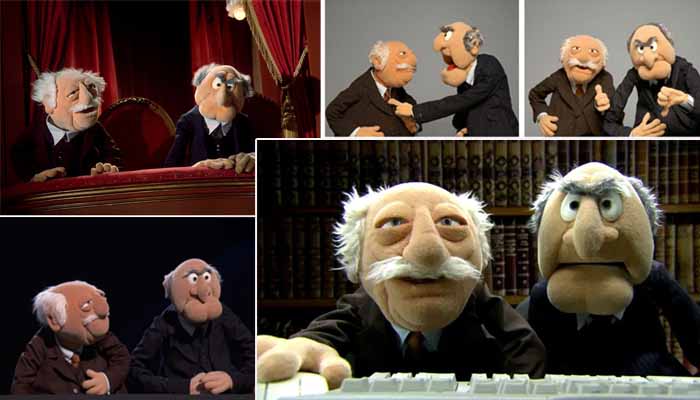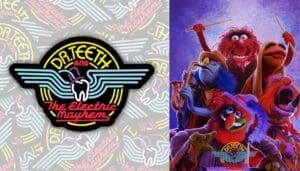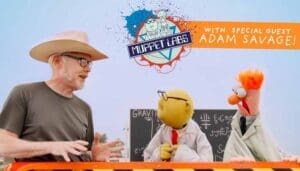“You think anyone will read this?”
“Why would they? It’s probably terrible!”
“DOHOHOHO!”
And so, with a familiar cackle echoing from the cheap seats of the internet, we dive into the glorious, grumpy world of Statler and Waldorf, The Muppet Show’s resident curmudgeons. From their privileged perch in the theater balcony, these two elderly gentlemen reigned supreme as the kings of critique, the sultans of snark, and the undisputed champions of finding fault with absolutely everything. Their jeers, aimed at the entire cast and their performances, were as much a staple of the show as Kermit’s flustered introductions or Miss Piggy’s karate chops.
We’re here to celebrate their unique legacy of laughter – a laughter often born at the expense of a certain perpetually struggling comedian bear. But beyond the zingers and the put-downs lies a delightful paradox: why did these two, who vociferously claimed to despise every minute of The Muppet Show, religiously attend every single performance, always occupying the best seats in the house?. This question, a riddle wrapped in a complaint inside an opera box, has baffled Muppet aficionados for generations. Their consistent presence, despite their unending stream of criticism, hints at something deeper than simple disdain; it suggests a peculiar, perhaps even unspoken, affection or necessity for the very show they so gleefully derided, making them far more intriguing than mere sideline snipers.
Meet the Hecklers: Who’s Who in the Grumpus Gallery? (And Why Are They So Well-Dressed?)
The masterminds behind these beloved grumps were Jim Henson and puppet designer Bonnie Erickson. Befitting their distinguished (and often disgruntled) demeanor, Statler and Waldorf were named after two grand New York City hotels: the Statler Hilton and the Waldorf-Astoria. There’s a certain delicious irony in such prestigious monikers being bestowed upon characters whose primary occupation was professional complaining.
For those who might struggle to differentiate between these icons of ill-temper (a common affliction, no judgment here), a simple guide: Statler is generally depicted as the taller of the two, with a long face, a more prominent nose, and receding grey, salt-and-pepper hair. Waldorf, on the other hand, sports a rounder, cheekier face, fluffy white hair, and a dapper mustache. Typically, Waldorf is seated to Statler’s right (which appears as the viewer’s left). This consistent visual differentiation, though seemingly minor, was instrumental in establishing them as a memorable duo with individual, albeit similarly cantankerous, personalities. Had they been identical, their rapid-fire exchanges might have lacked the conversational feel that made their partnership so dynamic.
Adding to their unique stage presence was their surprisingly formal attire. These were not your average, run-of-the-mill hecklers; these were hecklers of distinction, invariably clad in three-piece suits. Statler often favored pinstripes, exuding an air of “pure old school money,” while Waldorf’s deep warm brown suit suggested a slightly more “country but still establishment” vibe. Their quality clothing, combined with a grooming that could be charitably described as “slightly scruffy,” projected an undeniable aura of self-assurance. It was a look that loudly proclaimed, “We are so comfortable with our position in the world that we don’t give a rodent’s posterior about your feelings, or frankly, much else!”. This very juxtaposition of their “establishment” appearance with their decidedly anti-establishment, subversive heckling created a wonderful comedic dissonance. They were rebels in refined clothing, and their sharp, often crude, commentary felt all the more shocking and hilarious coming from figures who looked like they should be discussing stock portfolios, not the comedic failings of a talking frog.
The Art of the Heckle: “That Wasn’t Half Bad… It Was ALL Bad!”
Statler and Waldorf were true virtuosos of vexation, conducting a symphony of scorn from their balcony. Their comedic style was a finely tuned engine of rapid-fire banter, perfectly timed put-downs, and, most crucially, a shared, booming, self-satisfied laughter at their own witticisms. They truly did find themselves vastly entertaining, and this infectious mirth was a key component of their act. If they had delivered their scathing critiques with straight faces, the effect might have been uncomfortably cruel. Instead, their mutual chortling served as a clear signal to the audience: “This is the joke. It’s perfectly acceptable, nay, encouraged, to laugh along with our mockery.” This transformed potentially mean-spirited barbs into moments of shared comedic delight.
Their most frequent, and arguably most beloved, target was the perpetually optimistic and tragically unfunny Fozzie Bear. Fozzie’s earnest “Wocka Wocka!” was almost invariably met with a derisive counterpoint from the balcony, such as, “He was doing okay until he came ON the stage!”. Their dedication to dismantling Fozzie’s act was a running gag that never grew old, perhaps because Fozzie, bless his fuzzy heart, never seemed to improve.
But Statler and Waldorf weren’t just muttering to each other; they were acutely aware of the audience, both in the theater and at home. They frequently broke the fourth wall, most famously with Statler’s direct address: “Why do you watch it?”. This rhetorical question, as noted by author Ben Underwood, effectively blurred the boundary between performer and audience, making viewers complicit in their comedic cruelty and active participants in the show’s unique dynamic. Their heckling often followed classic comedic structures – setup, punchline, callback – making them less like simple critics and more like a meta-comedy act performing in parallel to the main stage show. They weren’t just commenting on the Muppets; they were delivering their own polished routine. The rare occasion when Fozzie Bear managed to successfully heckle them back only served to highlight how deeply ingrained their respective roles were. This momentary reversal of the established power dynamic was a delightful surprise, underscoring the consistency of their comedic formula.
To truly appreciate their genius, one must simply experience their “greatest hits”:
Statler & Waldorf’s Greatest (Worst?) Hits
| Quote | Speaker(s) | Context/Target (if applicable) | Source(s) |
|---|---|---|---|
| “This show is awful.” “Terrible.” “Disgusting.” “See you next week?” “Of course.” | Statler & Waldorf | General show commentary | |
| “Just when you think this show is terrible something wonderful happens.” “What?” “It ends.” | Waldorf, Statler | General show commentary | |
| “I like that last number.” “What did you like about it?” “It was the last number!” | Statler, Waldorf | Post-performance | |
| “They aren’t half bad!” “No, they’re all bad!” | Statler & Waldorf | General performance (common riff) | |
| “The question is ‘What is a Mahna Mahna?'” “The question is ‘Who cares?'” | Statler, Waldorf | Mahna Mahna sketch | |
| “Do you think this show is educational?” “Yes. It’ll drive people to read books.” | Statler, Waldorf | General show commentary | |
| “He was doing okay until he fell off the stage.” “Wrong. He was doing okay until he came ON the stage!” | Statler, Waldorf | Fozzie Bear’s act |
“Why Do We Always Come Here? I Guess We’ll Never Know!” (But We Have Theories!)
The most enduring question surrounding Statler and Waldorf is, of course, why they subjected themselves to what they described as “torture” week after week. Their own theme song in the fifth season of The Muppet Show immortalized this very query: “Why do we always come here? I guess we’ll never know. It’s like a kind of torture. To have to watch the show”. This central paradox has fueled decades of speculation and some truly inspired fan theories, each more delightfully outlandish than the last.
The sheer volume and creativity of these theories underscore the deep level of engagement these characters inspire; their ambiguous motivations are not a narrative flaw but a feature that invites endless discussion and imaginative participation from the audience.
Consider the theory that they are, in fact, broke and homeless, their dapper suits merely the only clothes they own, and the Muppet Theater their sole refuge from the elements. As one commentator noted, “Still, it’s pretty rude of them to treat the performers so poorly when they get a place to crash in exchange”. The delicious irony here is the stark contradiction between this theory and their “old money” appearance , making the idea even more preposterous and therefore funnier.
Or perhaps they are time travelers from a deeply disappointed future, who journeyed back to witness the legendary Muppet Show in its heyday, only to find it didn’t quite live up to their rose-tinted, nostalgic expectations. One can almost sympathize: “If you managed to travel back in time for a hilarious, iconic performance and instead got the world’s least funny bear, you’d heckle too”.
Another popular notion is that they were once stars of the very same Muppet Theater, now embittered by the current lineup and returning to relive their glory days, albeit through a haze of criticism. One source even claims it’s canon that they were former Vaudeville stars.
Then there’s the wonderfully meta theory that Statler and Waldorf don’t actually exist in the conventional sense. Instead, they are physical manifestations of Fozzie Bear’s crippling insecurities and self-doubt – his inner critics given form and voice. “Truly, Statler and Waldorf are Fozzie Bear’s Tyler Durden,” one theorist boldly proclaimed. This idea, while humorous, touches upon the universally relatable concept of the inner critic, lending their dynamic with Fozzie an unexpectedly profound, if accidental, psychological layer.
Other theories suggest they might be secretly in Kermit’s employ, hired to keep the cast on their toes and push them towards (an often unrealized) greatness , or that their attendance is a form of court-appointed community service, the show being considered such a theatrical travesty that enduring it serves as punishment.
Ultimately, the beauty of Statler and Waldorf’s motivation lies in its delicious ambiguity. The not knowing is an integral part of their charm, their unexplained, unwavering persistence a cornerstone of their comedic appeal.
Beyond the Muppet Theater: The Hecklers Go Global (And Into Different Eras!)
Statler and Waldorf’s unique brand of cantankerous commentary proved too potent to be confined to a single theater balcony. Their ability to seamlessly transition their core heckling persona into vastly different contexts – from Victorian England to the high seas to the digital age – is a testament to the fundamental strength and universality of their comedic archetype. They don’t just inhabit roles; they are Statler and Waldorf within those roles, always ready with a cutting remark.
Their cinematic career is particularly noteworthy. In The Muppet Christmas Carol, they memorably portrayed the ghosts of Jacob and Robert Marley, shackled not just by chains but by their eternal habit of criticism. When Ebenezer Scrooge (Michael Caine) accuses them of always criticizing him, they retort, “We were always heckling you”. The very invention of a “Robert Marley” alongside the novel’s Jacob Marley was a clear nod to the necessity of including both halves of this iconic duo. They later appeared as the long-suffering figureheads of the Hispaniola in Muppet Treasure Island, with Statler complaining about being stuck on the front of the ship, only for Waldorf to quip that it was still “better than being in the audience”. They also graced The Muppets (2011) and Muppets Most Wanted with their signature scorn.
On the small screen, they continued their reign of grump. In Muppets Tonight, they were often shown watching the new show on television from an assisted living facility, their critical faculties undiminished by the change in venue. Perhaps their most natural extension beyond the original show was their web series, Statler and Waldorf: From the Balcony, which ran from 2005 to 2006 on Movies.com. In this pioneering series, predating much of today’s character-driven online content, they reviewed upcoming films, proving their heckling skills were perfectly suited for movie criticism. This early foray into digital media demonstrated a savvy understanding of how to leverage established character equity in new and emerging platforms.
Their iconic status also led to numerous guest appearances across various media, a clear indication of their enduring popularity and recognizability as reliable comedic assets. They’ve heckled Spider-Man in a Marvel Team-Up comic , delivered their verdict on Weezer’s performance in the “Keep Fishin'” music video (“It wasn’t half bad… it was all bad!”) , offered commentary on President Barack Obama for The Tonight Show , lent their critical eyes to WWE Raw , and even made an appearance at The Game Awards. Creators consistently bring them back because they are guaranteed laugh-getters, their legacy ensuring their continued presence in the pop culture landscape.
The Enduring Legacy: More Than Just a Couple of Old Grumps (But Also, Definitely That)
The names “Statler and Waldorf” have transcended their puppet origins to become cultural shorthand for any pair of cantankerous, vociferous critics or hecklers. They are the archetypal grumpy commentators, the gold standard against which all other fictional (and sometimes real) critics are measured. Their enduring appeal is somewhat paradoxical: they achieved beloved status through relentless, unadulterated negativity. This speaks volumes about an audience’s capacity to appreciate well-crafted cynicism, sharp wit, and a masterfully honed comedic persona, even if that persona is perpetually displeased.
Why do we harbor such affection for these masters of mockery? Perhaps it’s the vicarious thrill of their unbridled, witty negativity. As The Huffington Post astutely observed, for many of their devoted fans, “You know the best way to cope with life’s difficulties is by laughing at someone else’s expense”. They also represent a certain type of audience member – the seasoned veteran who has seen it all and is not easily impressed, offering a distinct, if consistently critical, generational perspective within the Muppet universe.
While they certainly provided conflict, they were never true villains; rather, they were an indispensable part of The Muppet Show’s chaotic, loving family. Their style of humor – pointed, witty, and often derisive takedowns – can be seen as an early, puppet-based precursor to the “roast culture” and “snark” that have become so prevalent in contemporary internet commentary and comedy. They were, in essence, the original insult comics, albeit with felt skin and a penchant for balcony seating. Hadley Freeman of The Guardian even declared them “My heroes,” while Esquire magazine rightfully named them among “The 10 Most Entertaining Fictional Critics”.
Their unwavering commitment to attending a show they professed to loathe ultimately reinforces a curious truth: even flawed art or “bad” performances can foster a sense of community and repeated engagement, if only for the sheer joy of complaining about it together. They are, in many ways, the original “hate-watchers” who, deep down, probably couldn’t imagine their lives without the very thing they loved to hate.
“See You Next Week?” “Of Course!” (We Hope So, Anyway!)
Statler and Waldorf’s brand of grumpy joy is, it seems, eternal. Their timeless appeal lies in their relatability (who hasn’t felt like heckling something?), their impeccable comedic timing, and the sheer audacity of their complaints. The desire for them to utter their classic sign-off, “See you next week?” , wasn’t just theirs; it became an expectation, a comforting ritual for the audience. It signaled that despite the explosions, the off-key singing, and the bear’s bad jokes, some things in the Muppet universe remained wonderfully, reliably constant – including Statler and Waldorf’s unwavering commitment to complaining.
Their entire existence is a hilarious testament to the idea that sometimes, the critics can be just as entertaining, if not more so, than the show they’re critiquing. They proved that commentary itself can be an art form, and often, the most memorable part of any experience is the shared laughter derived from its delightful imperfections.
“Well, that’s the end of this article!”
“Good! It was getting a bit long.”
“Yeah, but was it any good?”
“It was certainly… written!” “DOHOHOHO!”




